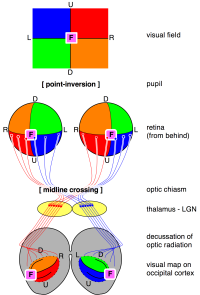Table of Contents
The Optic Chiasma
The optic chiasm1) is an X-shaped structure created through the crossing of the brain's optic nerves. The optic nerve connects the eye to the brain. The optic chiasm is believed to be a turning point in evolution for biologists. Crossing and uncrossing optic nerve fibers travelling through the optic chiasm are believed to have evolved in such a way to help with binocular vision and eye-hand coordination. Damage to this area may cause partial or total blindness.
Anatomy of The Optic Chiasm

Nerve fibers from half of each retina at the optic chiasm cross over to the brain's opposite side. The other half of the retina's fibers travel to the same part of the brain. Each half of the brain gets visual signals from both eyes ' visual areas because of this intersection.
The optic chiasm stretches at the level of the caudal border of the suprachiasmatic nucleus from the ventral surface of the caudal portion of the pre-optic area to the hypothalamus. The optic chiasm straddles the suprachiasmatic nucleus and the third ventricle instantly.
The optical tract passes to wrap around the hypothalamus and diencephalon laterally and caudally. The hypothalamus supraoptic nucleus surmounts the lateral edge of the optic tract.
Besides, the optic tract lies medially between the lateral hypothalamus and the cerebral peduncle, and laterally the amygdala's medial nucleus.
Vision and The Optic Chiasm
Ganglion cell axons converge on the retina region called the papilla or optic disk. They leave the globe as the optic nerve in which they maintain an orderly arrangement in the sense that fibres from the retina's macular zone occupy the central portion, fibers from the temporal half of the retina occupy a concentrated position, and so on; partial decussion (crossover) occurs outside of the orbit. The outcome of partial decussation is that an object in, say, the right visual field generates impacts in both eyes that are transferred only to the left side of the brain.
Vision was proposed as a mechanism for controlling distal motions. The human visual system has a unique elevated percentage of retinal ganglion cells (roughly 45%) that do not cross the midline of the optic chiasm. One way, like our own, to improve our knowledge of bilateral brains is to inspect their combined sensory systems. The optic nerves usually merge in our visual system at a location called the optic chiasm.
The Function of Optic Chiasm
The optic chiasm plays a crucial role in visual input information retinotopic depiction and is situated above the pituitary gland, anterior to the pituitary stalk, and inferior to the hypothalamus. At optic chiasm stage, it is estimated that 53% of optic nerve axons, predominantly nasal hemiretine, decuse to join the strands of the contralateral temporal hemiretine forming the optic tract. This decussation is intended to combine visual input data from two halves of each retina receiving light from the same part of the visual field.
Chiasmal Syndromes
This syndrome is caused by lesions of the optic chiasm, as the name implies. Chiasmal syndromes are the abnormalities of optic chiasm that can severely impair vision or even can cause blindness. The extent of vision loss is determined by the location of the lesion.
Chiasmal syndrome can be caused by either intrinsic or extrinsic factors.
Extrinsic causes include the compression of the optic chiasm by an extrinsic factor such as a vascular aneurysm caused by a tumour such as pituitary adenoma, meningioma, etc. The most common cause of chiasmal syndrome is pituitary adenomas.
Chiasma thickening is one of the intrinsic causes. Gliomas and multiple sclerosis are the most common intrinsic etiologies of chiasmal syndrome.
Pituitary Adenoma and The Optic Chiasm
A pituitary adenoma is the most prevalent disease affecting the optic chiasm. Pituitary adenomas are benign tumours. They do not affect at all in most cases, but in some instances, they may influence vision, sometimes causing vision loss. As pituitary adenomas grow in size, they can put pressure on essential structures in the body, such as the optic nerve. Pressing the optic nerve can cause blindness, so eye doctors must detect pituitary tumours before vision damage is caused.
The pituitary gland is about a bean's size and is tied behind the nasal region to the base of the brain. It lies under the optic chiasm. The pituitary, though small, regulates the secretion of many different hormone types. It helps to keep growth and development and controls a large number of various glands, organs and hormones. Hormone changes can trigger significant changes in our bodies.
Optic Chiasm and Common Diseases
When an illness or lesion affects the optic nerve before it hits the optic chiasm in the brain, the vision defect appears in one eye only and can change the whole field of the eye. Sometimes people who have a single defect do not realise it until one eye is covered. This is because each eye's overlapping visual fields will mask the deficiency when both eyes are open. If the disease affects the optic tract after the chiasm, in both eyes, the person will have a vision defect, but the defect will alter the same visual field half.